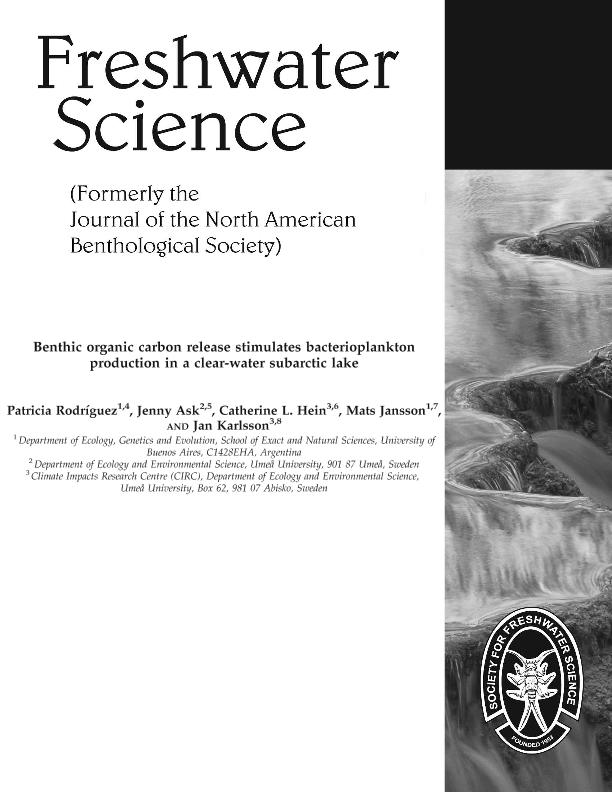Mostrar el registro sencillo del ítem
dc.contributor.author
Rodriguez, Patricia Laura

dc.contributor.author
Ask, Jenny
dc.contributor.author
Hein, Catherine L.
dc.contributor.author
Jansson, Mats
dc.contributor.author
Karlsson, Jan
dc.date.available
2015-10-13T14:37:18Z
dc.date.issued
2013-03
dc.identifier.citation
Rodriguez, Patricia Laura; Ask, Jenny; Hein, Catherine L.; Jansson, Mats; Karlsson, Jan; Benthic organic carbon release stimulates bacterioplankton production in a clear-water subarctic lake; University of Chicago Press; Freshwater Science; 32; 1; 3-2013; 176-182
dc.identifier.issn
2161-9549
dc.identifier.uri
http://hdl.handle.net/11336/2501
dc.description.abstract
We carried out a set of experiments in a small clear-water lake in northern Sweden during summer 2010 to assess the effect of organic C (OC) released from epipelic algae on pelagic bacterial production (BP). The release rate of OC (dissolved and particulate) from epipelic algae was ,45.4 ng C m22 h21 . Bacterioplankton uptake of dissolved OC was P-limited, and pelagic primary production (PP) was colimited by N and P. Pelagic BP (3.2 6 6 mgCL21 h21 ) exceeded pelagic PP (0.012 6 0.008 mg C L21 h21 ). Pelagic BP was higher in lake water in contact with sediments and the epipelic algae growing on their surface than in water separated from the sediments. Epipelic algae release OC to lake water and potentially stimulate pelagic BP. However, exploitation of benthic OC probably is suboptimal because of nutrient limitation (primarily by inorganic P) of BP.
dc.format
application/pdf
dc.language.iso
eng
dc.publisher
University of Chicago Press
dc.rights
info:eu-repo/semantics/openAccess
dc.rights.uri
https://creativecommons.org/licenses/by-nc-sa/2.5/ar/
dc.subject
BACTERIOPLANKTON PRODUCTION
dc.subject
BENTHIC ALGAE
dc.subject
CLEAR-WATER LAKE
dc.subject
ORGANIC CARBON
dc.subject
SEDIMENT
dc.title
Benthic organic carbon release stimulates bacterioplankton production in a clear-water subarctic lake
dc.type
info:eu-repo/semantics/article
dc.type
info:ar-repo/semantics/artículo
dc.type
info:eu-repo/semantics/publishedVersion
dc.date.updated
2016-03-30 10:35:44.97925-03
dc.identifier.eissn
2161-9565
dc.journal.volume
32
dc.journal.number
1
dc.journal.pagination
176-182
dc.journal.pais
Estados Unidos

dc.journal.ciudad
Chicago
dc.conicet.avisoEditorial
© 2013 by The Society for Freshwater Science
dc.description.fil
Fil: Rodriguez, Patricia Laura. Consejo Nacional de Investigaciones Científicas y Técnicas. Oficina de Coordinación Administrativa Ciudad Universitaria. Instituto de Ecología, Genética y Evolución de Buenos Aires; Argentina. Universidad de Buenos Aires. Facultad de Ciencias Exactas y Naturales. Departamento de Ecología, Genética y Evolución; Argentina
dc.description.fil
Fil: Ask, Jenny. Umea University. Department of Ecology and Environmental Science; Suecia;
dc.description.fil
Fil: Hein, Catherine L.. Umea University. Department of Ecology and Environmental Science. Climate Impacts Research Center; Suecia;
dc.description.fil
Fil: Jansson, Mats. Universidad de Buenos Aires. Facultad de Ciencias Exactas y Naturales. Departamento de Ecología, Genética y Evolución; Argentina
dc.description.fil
Fil: Karlsson, Jan. Umea University. Department of Ecology and Environmental Science. Climate Impacts Research Center; Suecia;
dc.journal.title
Freshwater Science
dc.relation.alternativeid
info:eu-repo/semantics/altIdentifier/doi/http://dx.doi.org/10.1899/12-005.1
dc.relation.alternativeid
info:eu-repo/semantics/altIdentifier/url/http://www.bioone.org/doi/abs/10.1899/12-005.1
Archivos asociados
